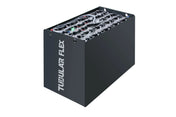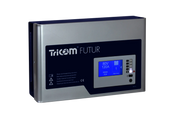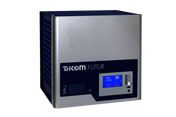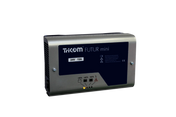What does the 20% limit mean for forklift batteries?
The 20% limit describes the point at which a lead-acid battery becomes chemically unstable. Below this mark, processes begin that permanently reduce performance. For a 48V battery, this corresponds to approximately 46 volts total voltage – or around 1.86 V per cell. From this point on, it becomes critical: The battery loses capacity, heats up more, and can no longer be fully charged.
Why deep discharge is so dangerous
If the state of charge drops below 20%, lead sulfate crystals are permanently deposited on the plates. These "clog" the active surface, increasing the internal resistance and reducing the battery's ability to accept current. Simultaneously, the acid density changes, leading to stratification and uneven stress on the cells. The result: power loss, overheating, and in the worst case, a short circuit.
Typical causes of deep discharge
Over 70% of all deep discharges are caused by incorrect charging behavior or defective components. Common causes include:
- Extended operating times without recharging
- Incorrect charger setting or defective charger
- Excessive ambient temperature (over 30 °C)
- Defective or loose cable connections
- Faulty discharge indicator or cutoff threshold too low
- Longer periods of inactivity without trickle charging
- Inadequate maintenance or lack of water level compensation
Early warning signs: How to recognize an impending deep discharge
A battery usually gives warning signs before it fails. You should take these signals seriously:
- The travel time per shift decreases significantly – from approximately 8 hours to 5 hours.
- The forklift becomes sluggish, especially when lifting.
- The battery voltage drops faster than usual (more than 0.2 V per cell in a short time).
- The battery heats up unusually much during charging.
If these symptoms occur, the charge level should be measured and the battery recharged or checked immediately.
The C5 value explained simply
The C5 rating indicates how much current a battery can deliver in five hours. A 100 Ah C5 battery, therefore, delivers 20 A for five hours before it has used 80% of its capacity. In practical terms, this means that after approximately 4–5 hours of driving, the battery is at a safe recharging point. Driving longer risks deep discharge and a shortened lifespan.
Measurement values for orientation
| Cell voltage | SOC area | status | Recommendation |
|---|---|---|---|
| ≥ 2.07 V | > 30% | secure | Normal work |
| 1.86–2.07 V | 20–30% | Warning area | Schedule a visit |
| 1.79–1.86 V | ≈ 20% | Critical | Download now |
| < 1.75 V | < 10% | Deep discharge | Damage likely |
Temperature and lifespan
Temperature is a crucial factor: Above 30 °C, the lifespan of many batteries is halved because chemical reactions accelerate. In freezing temperatures (< 0 °C), the electrolyte can even freeze. 20–25 °C is ideal – at this temperature, cells operate stably and self-discharge remains low.
What to do if the battery is already deeply discharged?
Act immediately. The faster you react, the greater the chance of rescue.
- Check the state of charge: Measure the voltage per cell – if it is above 1.75 V, regeneration is still possible.
- Start slow charging: Charge at approximately C/20 (at 100 Ah = 5 A) until each cell reaches 2.0 V again.
- Perform a full charge: Then charge normally (IUoU method) until gas voltage is reached.
- Check: After 24 hours, check cell voltage and electrolyte density. Values should remain stable.
- Technical inspection: If unsure, hand the battery over to a specialist company – if necessary, carry out desulfation.
After more than three days of deep discharge, the chances of success drop drastically. After that, replacement is usually the only option.
Desulfation or replacement – which is worthwhile and when?
Not every deeply discharged battery is beyond repair. Whether desulfation is worthwhile depends on the degree of crystal formation. As long as the crystal volume is below 25% , desulfation can restore up to 80% of the original capacity. The process is economical if the battery is structurally sound and has no short circuits in the cells.
In cases of severely hardened sulfate crystals, damaged plates, or multiple defective cells, a complete replacement is usually more cost-effective and safer. In such cases, it should be checked whether a regenerated or used replacement system is available – this saves costs and conserves resources.
How to reliably prevent deep discharge
Automatic protection systems and monitoring
Modern batteries are equipped with a battery management system (BMS) or intelligent discharge indicators. A BMS continuously monitors the voltage, temperature, charge cycles, and current flow of each cell. It detects uneven discharges early, protects against overcharging, and automatically shuts down the forklift before the critical range is reached.
Many BMS systems also store the charging history – this allows operators to plan maintenance cycles, check chargers, and identify potential problems before failures occur. Integration with fleet management systems is also now standard practice.
Regular maintenance
Check the electrolyte density and water level monthly, clean the terminals and connectors, and monitor the temperature during charging. Minor maintenance significantly extends the battery's lifespan.
Best practices in business
- Never drive below 20% SOC
- Reload after each shift
- Activate trickle charging during extended periods of inactivity.
- Intermediate charging is allowed – a quick reload won't hurt.
- Store the battery in a cool, dry place.
Practical rule of thumb for operators
Forklifts should be recharged after five hours of typical use – this corresponds to approximately 80% discharge. This simple rule protects the battery, saves energy, and reduces downtime. Regularly checking and charging the battery, and respecting the 20% discharge limit, prevents costly damage and keeps your forklift fleet operational at all times.
Conclusion
Deep discharge is one of the most common causes of battery failure – and almost always avoidable. The 20% mark is not a recommendation, but a physical limit. Those who respect it, perform regular maintenance, and use modern charging and monitoring systems can extend the lifespan of their forklift batteries by years – and sustainably reduce operating costs.







